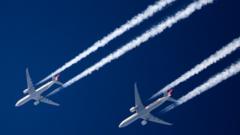Recent discussions in the aviation sector have put a spotlight on the significant climate effects of jet condensation trails, commonly known as contrails. A new study conducted by the Transport & Environment campaign group highlights that combating the climate damage caused by these trails could be achieved for mere pounds per flight.
Contrails, the white streaks left behind by flying aircraft, have long been linked to conspiracy theories surrounding mind control and disease outbreaks. However, scientists assert that the real issue lies in their contribution to global warming. Reports indicate that contrails can nearly double the warming effect associated with the combustion of fossil fuels in aviation. This crucial topic will receive its first formal discussion during the upcoming UN climate conference, COP29, taking place in Baku.
The process behind contrail formation is akin to observing one’s breath on a frosty day. When planes fly through humid, cold air, water vapor from engine exhaust condenses into visible trails. Although the phenomenon has been identified for decades, its role in exacerbating climate change has only recently gained attention among researchers.
Carlos Lopez de la Osa, from Transport & Environment, explains, “Contrails create an artificial cloud layer that traps heat trying to escape from our planet.” The group’s study reveals that the warming associated with contrails has effects similar to those of carbon emissions from aviation.
Despite myths surrounding “chemtrails,” there is no scientific basis for such claims, according to Matteo Mirolo of Breakthrough Energy. “Conspiracy theories detract from an important issue that requires a clear consensus,” he states.
The findings from the study indicate that nearly 80% of contrail warming arises from just 3% of flights. By altering the flight paths of selected aircraft, substantial reductions in warming could be realized—over 50% by 2040 at a cost lower than £4 per flight. The geography of flight routes greatly affects contrail warming, with areas over North America, Europe, and the North Atlantic being particularly impactful. Additionally, evening and night flights contribute more to warming, with winter producing the most detrimental contrails.
“A simple adjustment to flight planning to avoid regions conducive to contrail formation could yield significant benefits,” suggests Lopez de la Osa. He emphasizes that this solution is one of the simplest among options being discussed at COP29.
The researchers aim to increase awareness of contrails’ climate impact at COP29 while advocating for practical solutions that come at a fraction of the expense compared to other climate initiatives currently being explored in the aviation industry.



















